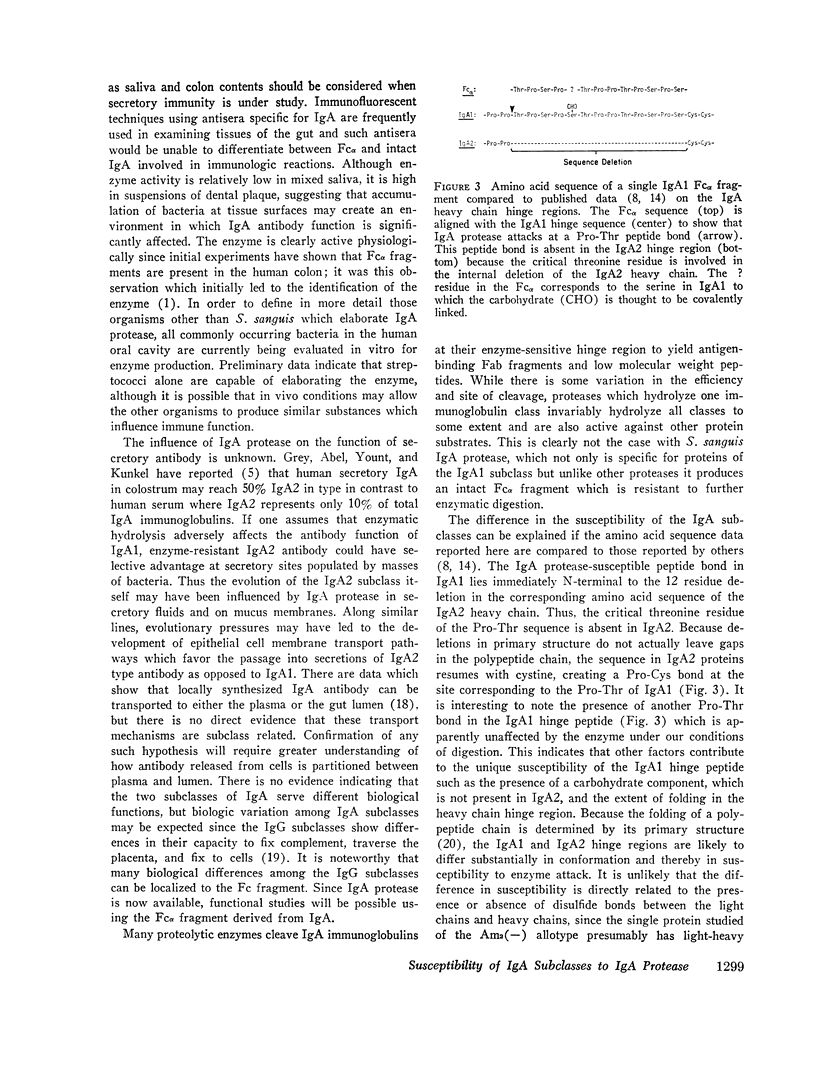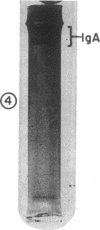Abstract
IgA protease, a proteolytic enzyme found in human saliva and colonic fluid, hydrolyzes human serum IgA immunoglobulins to yield Fabα and Fcα fragments. The enzyme is produced by organisms in the normal human microflora and can be purified from culture filtrates of the common human oral organism Streptococcus sanguis (American Type Culture Collection no. 10556). IgA protease is inactive against all other protein substrates examined including the other classes of human immunoglobulins. The role of this enzyme in affecting the function of the secretory IgA immune system is unknown.
To further characterize and explain this unusual substrate specificity, the susceptibility of 31 human IgA myeloma proteins of both subclasses was investigated. 16 IgA1 and 15 IgA2 myeloma paraproteins were treated with enzyme and the extent of proteolysis was determined by cellulose actate electrophoresis, immunoelectrophoresis, polyacrylamide gel electrophoresis, and column chromatography. All IgA1 proteins were enzymatically cleaved to Fabα and Fcα fragments, but all IgA2 proteins were resistant, yielding no fragments after prolonged enzymatic treatment. N-terminal amino acid sequence analysis of the purified Fcα fragment of a single IgA1 paraprotein was as follows: Thr-Pro-Ser-Pro-?-Thr-Pro-Pro-Thr-Pro-Ser-Pro-Ser. Comparison of this sequence to that reported for the IgA1 heavy chain shows that the enzyme-susceptible peptide bond is a Pro-Thr in the IgA1 hinge region. The most likely explanation of the resistance of the IgA2 subclass to IgA protease is a deletion in the heavy chain which commences with the critical threonine of the susceptible Pro-Thr bond.
Full text
PDF





Images in this article
Selected References
These references are in PubMed. This may not be the complete list of references from this article.
- Abel C. A., Grey H. M. Structural differences in the hinge region of human gamma A myeloma proteins of different subclasses. Nat New Biol. 1971 Sep 1;233(35):29–31. doi: 10.1038/newbio233029a0. [DOI] [PubMed] [Google Scholar]
- Capra J. D. Hypervariable region of human immunoglobulin heavy chains. Nat New Biol. 1971 Mar 10;230(10):61–63. doi: 10.1038/newbio230061a0. [DOI] [PubMed] [Google Scholar]
- Capra J. D., Wasserman R. L., Kehoe J. M. Phylogenetically associated residues within the VH3 subgroup of several mammalian species. Evidence for a "pauci-gene" basis for antibody diversity. J Exp Med. 1973 Aug 1;138(2):410–427. doi: 10.1084/jem.138.2.410. [DOI] [PMC free article] [PubMed] [Google Scholar]
- Carlsson J. Presence of various types of non-haemolytic streptococci in dental plaque and in other sites of the oral cavity in man. Odontol Revy. 1967;18(1):55–74. [PubMed] [Google Scholar]
- Crabbé P. A., Bazin H., Eyssen H., Heremans J. F. The normal microbial flora as a major stimulus for proliferation of plasma cells synthesizing IgA in the gut. The germ-free intestinal tract. Int Arch Allergy Appl Immunol. 1968;34(4):362–375. doi: 10.1159/000230130. [DOI] [PubMed] [Google Scholar]
- Frangione B., Wolfenstein-Todel C. Partial duplication in the "hinge" region of IgA 1 myeloma proteins. Proc Natl Acad Sci U S A. 1972 Dec;69(12):3673–3676. doi: 10.1073/pnas.69.12.3673. [DOI] [PMC free article] [PubMed] [Google Scholar]
- Grey H. M., Abel C. A., Yount W. J., Kunkel H. G. A subclass of human gamma-A-globulins (gamma-A2) which lacks the disulfied bonds linking heavy and light chains. J Exp Med. 1968 Dec 1;128(6):1223–1236. doi: 10.1084/jem.128.6.1223. [DOI] [PMC free article] [PubMed] [Google Scholar]
- Jerry L. M., Kunkel H. G., Grey H. M. Absence of disulfide bonds linking the heavy and light chains: a property of a genetic variant of gamma-A2 globulins. Proc Natl Acad Sci U S A. 1970 Mar;65(3):557–563. doi: 10.1073/pnas.65.3.557. [DOI] [PMC free article] [PubMed] [Google Scholar]
- Knight K. L., Lichter E. A., Hanly W. C. Papain cleavage of rabbit secretory immunoglobulins A. Differential sensitivity of f and g subclasses. Biochemistry. 1973 Aug 14;12(17):3197–3203. [PubMed] [Google Scholar]
- Kunkel H. G., Smith W. K., Joslin F. G., Natvig J. B., Litwin S. D. Genetic marker of the gamma-A2 subgroup of gamma-A immunoglobulins. Nature. 1969 Sep 20;223(5212):1247–1248. doi: 10.1038/2231247a0. [DOI] [PubMed] [Google Scholar]
- Mehta S. K., Plaut A. G., Calvanico N. J., Tomasi T. B., Jr Human immunoglobulin A: production of an Fc fragment by an enteric microbial proteolytic enzyme. J Immunol. 1973 Oct;111(4):1274–1276. [PubMed] [Google Scholar]
- SCHEIDEGGER J. J. Une micro-méthode de l'immuno-electrophorèse. Int Arch Allergy Appl Immunol. 1955;7(2):103–110. [PubMed] [Google Scholar]
- Tomasi T. B., Grey H. M. Structure and function of immunoglobulin A. Prog Allergy. 1972;16:81–213. [PubMed] [Google Scholar]
- Tomasi T. B., Jr, Bienenstock J. Secretory immunoglobulins. Adv Immunol. 1968;9:1–96. doi: 10.1016/s0065-2776(08)60441-1. [DOI] [PubMed] [Google Scholar]
- Vaerman J. P., Heremans J. F. Subclasses of human immunoglobulin a based on differences in the alpha polypeptide chains. Science. 1966 Aug 5;153(3736):647–649. doi: 10.1126/science.153.3736.647. [DOI] [PubMed] [Google Scholar]
- Virella G., Parkhouse R. M. Papain sensitivity of heavy chain sub-classes in normal human IgG and localizaton of antigenic determinants for the sub-classes. Immunochemistry. 1971 Mar;8(3):243–250. doi: 10.1016/0019-2791(71)90478-2. [DOI] [PubMed] [Google Scholar]
- Wolfenstein-Todel C., Mihaesco E., Frangione B. "Alpha chain disease" protein def: internal deletion of a human immunoglobulin A1 heavy chain. Proc Natl Acad Sci U S A. 1974 Mar;71(3):974–978. doi: 10.1073/pnas.71.3.974. [DOI] [PMC free article] [PubMed] [Google Scholar]










